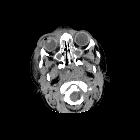proptosis








Proptosis refers to forward protrusion of the globe with respect to the orbit. There are many causes of proptosis which can be divided according to location and it is worth remembering that it is not just orbital disease processes that cause proptosis.
Terminology
Exophthalmos also describes forward protrusion of the globe. Several authors use the terms differently, which can be confusing:
- proptosis and exophthalmos are often used interchangeably
- exophthalmos used to refer to severe (>18 mm) proptosis
- exophthalmos used to refer to endocrine-related proptosis
Proptosis can also be used for other viscera (although rarely seen in contemporaneous usage), but exophthalmos only for the eyes.
Enophthalmos is the opposite, referring to displacement of the globe posteriorly.
Pathology
Etiology
The causes of proptosis are broad and include a wide range of mass lesions that originate within the cranium, sinuses, paranasal spaces, and orbit :
- thyroid orbitopathy (the most common cause of uni/bilateral proptosis in adults)
- infection
- orbital cellulitis
- orbital mucocele
- sinusitis
- tumor
- lymphoma, e.g. orbital lymphoma
- meningioma, e.g. sphenoid wing meningioma
- glioma
- orbital metastasis
- trauma, e.g. iatrogenic, post-surgical
- vascular lesions
- carotid-cavernous fistula
- capillary hemangioma
- cavernous hemangioma also known as orbital venous malformation
- orbital varix
- AVM
- orbital inflammatory syndrome (also known as orbital pseudotumor)
- pseudoproptosis
Radiographic features
CT
Assessment of proptosis on cross-sectional imaging is difficult and dependent on the study being acquired in the correct plane:
- the plane of the study must be parallel to the head of the optic nerve and the lens
- the patient must have their eyes open and be looking forward with no eye movement
The reference line for measurement of proptosis is the interzygomatic line (a line is drawn at the anterior portions of the zygomatic bones):
- the distance from this line to the posterior sclera is normally 9.9 +/- 1.7 mm
- the distance from this line to the anterior surface of the globe should be <23 mm
The thickness of the extraocular muscles can also be used .
MRI
MRI may also be used in evaluation due to its multiplanar and the inherent contrast capabilities. Use of MR prevents ionizing radiation of the orbits. The imaging findings are similar to those described above for CT.
Siehe auch:
- Arteriovenöse Malformation
- Kavernom
- inflammatorischer Pseudotumor der Orbita
- orbitales Lymphom
- Metastasen in der Orbita
- Tumoren am Keilbeinflügel
- Orbitaphlegmone
- Graves ophthalmopathy
- Orbita
- Luxation des Bulbus oculi
- pulsatiler Exophthalmus
und weiter:
- Keilbeinmeningeom
- En Plaque Meningiom am Keinbeinflügel
- Knochenmetastasen des Schädels
- Pfeiffer-Syndrom
- oculomotor nerve palsy
- dysthyroid eye disease
- Neu-Laxova-Syndrom
- Lymphangiom der Orbita
- Klassifikation Osteogenesis imperfecta
- Carotis-Sinus-cavernosus-Fistel
- arachnoid cysts causing proptosis
- Pilozytisches Astrozytom des Nervus opticus

 Assoziationen und Differentialdiagnosen zu Exophthalmus:
Assoziationen und Differentialdiagnosen zu Exophthalmus:









